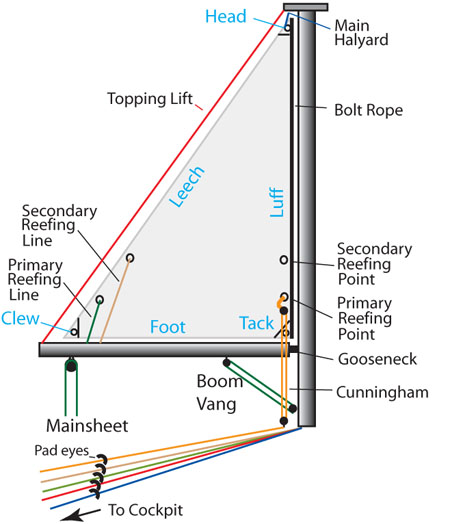This is a continuing learning how to sail article on Reefing the Sails. This has been written by Grant Headifen of NauticEd Sailing School.
In the previous Learn to Sail article on reefing we convinced you pretty hard on why you should reef the sails. So now let’s learn how to reef the mainsail.
When getting underway, mainsails are either hoisted up the mast or unfurled (unrolled) out of the mast. When reefing the mainsail, you are reducing the size of the sail area presented to the wind. If the mainsail is hoisted, then to reef, you will be lowering the sail slightly. If the mainsail is typically furled into the mast, you will be furling the sail into the mast a little to reef it.
Reefing the Mainsail by Furling Into the Mast
This is simple. You first must take the wind load off the sail. You can either motor into the wind or use the jibsail to head onto a close haul or close reach and let the mainsheet out until the load disappears from the mainsail. Then wrap the mainsail outhaul around the winch and release the clutch holding the outhaul. Leave the outhaul wrapped once around the winch to create some back tension. This is important so that the mainsail wraps up tightly inside the mast. Otherwise, if it is too loose, a loosely wrapped mainsail will not fit into the mast and will over wrap on it self creating a huge problem when you next try to unfurl. Now furl in the mainsail using the inhaul or infurl line to the desired amount. Usually there is a 1st reef and 2nd reef position marked on the sail. It is VERY important to only tension the sail back up using the outhaul line NOT the inhaul line otherwise you will damage the inhaul system. This is a classic mistake by new sailors as they learn to sail.
Reefing the Mainsail by Lowering the Sail.
Note that if you have a mainsail inmast furling system do not use this method. Although in an emergency you probably could but the sail should be all the way unfurled before you attempt it. More than likely however there will be no reefing grommets in the sail anyhow.
Here you are lowering the sail a little into a boom furling system, a stac pac – which is a long bag on top of the boom or you’ll just lash the unused portion of the sail to the boom using lines that run through grommet holes along the sail at the reefing points. And by the way, this is where the reef knot is so named. You’ll use the reef knot to lash the sail to the boom.
To reef then, take the load off the mainsail by motoring into wind or by using the jibsail to head onto a close haul or close reach and then let out the mainsheet until the load is removed from the mainsail. Wrap the main halyard around a winch and release the clutch for the halyard. Lower the mainsail to the desired reefing point.
At the mast there will be a hook system to hook into reefing grommets along the leading edge of the main sail. Or there will be lines running up to those reefing grommets. Either way, you will be using these to pull down the sail. Some sailboats are rigged with a Cunningham which is a pulley system which gives you more leverage.

The Main Sail
At the leach (trailing edge) of the mainsail there will also be grommet reefing holes and most likely there will be lines to also pull those down to the boom. Ensure that you pull down the luff (leading edge) first before you pull down the leach otherwise you can damage the sail. As you learn to sail you’ll begin to gain a real appreciation for the order of performing such tasks.
The leach reefing lines sometimes will run down along the boom to the mast end. The first and second reef lines are usually distinguished by being different colors.
Now re-tension the halyard. If the boat is fitted with a Cunningham, now use it to further adjust the tension of the luff.
Once the luff and leach are secured, and if you don’t have a stac pac, lash any loose sail down using the reefing grommets.
If you boat is fitted with a boom furling system, most of the above is relevant except instead of pulling down with the reefing lines, you’ll just furl (wind) the sail into the boom. You’ll need to keep a little tension on the halyard to ensure the sail wraps firmly into the boom. Do not down tension the mainsail luff using the boom furling system. Rather use the halyard and Cunningham to do your tensioning.
We hope you enjoy this learn to sail series on reefing the sail. Please continue to read our other articles.
If youre serious about learning to sail, consider the NauticEd Skipper Sailing Course.
This learn to sail article was written by Grant Headifen, Educational Director of NauticEd Sailing School. NauticEd is an online sailing school providing sailing courses and sailing certifications for beginner to advanced sailors.
